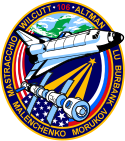STS-106
 | |
| Dane misji | |
| Indeks COSPAR | 2000-053A |
|---|---|
| Zaangażowani | |
| Oznaczenie kodowe | STS-106 |
| Pojazd | |
| Wahadłowiec | |
| Załoga | |
 Tylny rząd od lewej: Morukow, Mastracchio, Lu, Burbank, Malenczenko; z przodu od lewej: Altman, Wilcutt | |
| Dowódca | |
| Start | |
| Miejsce startu | |
| Początek misji | 8 września 2000 12:45:47 UTC |
| Orbita okołoziemska | |
| Apogeum | 387 km |
| Perygeum | 375 km |
| Okres orbitalny | 92,2 min |
| Inklinacja orbity | 51,6° |
| Lądowanie | |
| Miejsce lądowania | KSC, pas startowy 15 |
| Lądowanie | 20 września 2000 07:56:48 UTC[1] |
| Czas trwania misji | 11 dni, 19 godzin, 11 minut i 2 sekundy[2] |
| Przebyta odległość | 7,9 mln km[2] |
| Liczba okrążeń Ziemi | 185[2] |
| Program lotów wahadłowców | |
STS-106 (ang. Space Transportation System) – jedenastodniowa misja wahadłowca Atlantis do Międzynarodowej Stacji Kosmicznej. Był to dwudziesty drugi lot promu kosmicznego Atlantis i dziewięćdziesiąty dziewiąty programu lotów wahadłowców[3].
Załoga
- Terrence Wilcutt (4)*, dowódca (CDR)
- Scott D. Altman (2), pilot (PLT)
- Daniel C. Burbank (1), specjalista misji (MS3)
- Edward Lu (2), specjalista misji (MS1)
- Richard A. Mastracchio (1), specjalista misji (MS2)
- Jurij Malenczenko (2), specjalista misji (MS4) (Rosja)
- Boris Morukow (1), specjalista misji (MS5) (Rosja)
- *(w nawiasie podano liczbę lotów odbytych przez każdego z astronautów)
Parametry misji
- Masa:
- startowa orbitera: 115 259 kg
- lądującego orbitera: 100 369 kg
- ładunku: 10 219 kg
- Perygeum: 375 km[5]
- Apogeum: 387 km[5]
- Inklinacja: 51,6° [5]
- Prędkość: 28 000 km/h
- Okres orbitalny: 92,2 min[5]
Cel misji
Czwarty lot wahadłowca na stację kosmiczną ISS – aktywacja nowo zainstalowanego rosyjskiego modułu obsługowego Zwiezda (wyniesionego na orbitę w lipcu 2000 r. przy pomocy rakiety Proton)[3].
Dokowanie do ISS
- Połączenie z ISS: 10 września 2000, 05:51:25 UTC
- Odłączenie od ISS: 18 września 2000, 03:46:00 UTC
- Łączny czas dokowania: 7 dni 21 godzin 54 minut 35 sekund
Spacer kosmiczny
- EVA (11 września 2000, 6 godz. 14 min): E. Lu, J. Malenczenko.
Zobacz też
Przypisy
- ↑ STS-106. [w:] Weebau Space Encyclopedia [on-line]. [dostęp 2017-07-27]. (ang.).
- ↑ a b c Podsumowanie misji STS-106 na stronie KSC. [dostęp 2010-08-31]. (ang.).
- ↑ a b c Tomáš Přibyl: Dzień, w którym nie wróciła COLUMBIA. Bielsko-Biała: Wydawnictwo >DEBIT<, 2003, s. 174. ISBN 83-7167-224-1.
- ↑ Robert Godwin: Space Shuttle. Warszawa: Prószyński Media Sp. z o.o., 2011, s. 82. ISBN 978-83-7648-973-5.
- ↑ a b c d Mark Wade: STS-106. [w:] Encyclopedia Astronautica [on-line]. [dostęp 2017-07-27]. (ang.).
Linki zewnętrzne
- podsumowanie misji STS-106 na stronie KSC (ang.)
- Mark Wade: STS-106. [w:] Encyclopedia Astronautica [on-line]. [dostęp 2017-07-27]. (ang.).
- Spaceflight mission report: STS-106. Spacefacts. [dostęp 2017-07-27]. (ang.).
Media użyte na tej stronie
The flag of Navassa Island is simply the United States flag. It does not have a "local" flag or "unofficial" flag; it is an uninhabited island. The version with a profile view was based on Flags of the World and as a fictional design has no status warranting a place on any Wiki. It was made up by a random person with no connection to the island, it has never flown on the island, and it has never received any sort of recognition or validation by any authority. The person quoted on that page has no authority to bestow a flag, "unofficial" or otherwise, on the island.
STS106-S-0002 (June 2000): Five NASA astronauts and two cosmonauts representing the Russian Aviation and Space Agency take a break in training from their scheduled September 2000 visit to the International Space Station. Astronauts Terrence W. Wilcutt (right front) and Scott D. Altman (left front) are mission commander and pilot, respectively, for the mission. On the back row are the mission specialists. They are (from left) cosmonaut Boris V. Morukov, along with astronauts Richard A. Mastracchio, Edward T. Lu and Daniel C. Burbank and cosmonaut Yuri I. Malenchenko. Morukov and Malenchenko represent the Russian Aviation and Space Agency.
This is the crew patch for the STS-106 mission, which is the first Shuttle flight to the International Space Station since the arrival of its newest component, the Russian-supplied Service Module Zvezda (Russian for star). Zvezda is depicted on the crew patch mated with the already orbiting Node 1 Unity module and Russian-built Functional Cargo Block, called Zarya (sunrise), with a Progress supply vehicle docked to the rear of the Station. The International Space Station is shown in orbit with Earth above as it appears from the perspective of space. The Astronaut Office symbol, a star with three rays of light, provides a connection between the Space Shuttle Atlantis and the Space Station, much the same as the Space Shuttle Program is linked to the International Space Station during its construction and future research operations. Stylized versions of flags from Russia and the United States meet at the Space Station. They symbolize both the cooperation and joint efforts of the two countries during the development and deployment of the permanent outpost in space as well as the close relationship of the American and Russian crew members.




